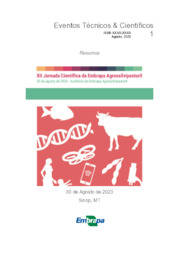Individual cattle face recognition through computer vision.
Individual cattle face recognition through computer vision.
Autoria: BENICIO, L. M.; XAVIER, D. B.; LIMA, I. B. G. de; PEREIRA, D. H.; CONDOTTA, I. C. F. da S.; LOPES, L. B.
Resumo: Abstract: Identifying a single animal in a herd allows for individual management and association, and traceability over time of each animal. Over the years, methods have been adopted to identify animals individually, such as using ear tags, visible ear tags, tattoos, and radio frequency identification devices (RFID). However, a disadvantage of this system is that the tool requires much work to configure (identification and tracking system), and the cost to install and replace the RFID tags must be considered. Systems based on image processing can be considered alternatives for individual identification of farm animals, as it is a non-invasive tool, is easy to apply, and can be adopted in real-time. Furthermore, it is possible to monitor more than one animal simultaneously individually. Several authors have used images to identify animals by face images, using the individual pattern as an ID. This work aims to analyze to develop an automatic individual identification of Nellore cattle through facial recognition using computer vision techniques. Facial images were collected from 30 Nellore males during weighing using the Intel RealSense camera. Then, only the face region of the animals was selected automatically, and an image classification model, using Yolo architecture version 8, was developed. Preliminary results showed an accuracy of 95% when correlating the animal's face with the identification number without the need to use identification ear tags. Thus, the proposed model presents potential for field applicability in individual animal recognition. The following steps of this research will include a more significant number of animals in the model and field testing to validate the methodology.
Ano de publicação: 2023
Tipo de publicação: Resumo em anais e proceedings
Unidade: Embrapa Agrossilvipastoril
Palavras-chave: Animal identification, Computer vision, Face
Observações
1 - Por padrão são exibidas publicações dos últimos 20 anos. Para encontrar publicações mais antigas, configure o filtro ano de publicação, colocando o ano a partir do qual você deseja encontrar publicações. O filtro está na coluna da esquerda na busca acima.
2 - Para ler algumas publicações da Embrapa (apenas as que estão em formato ePub), é necessário ter, no celular ou computador, um desses softwares gratuitos. Sistemas Android: Google Play Livros; IOS: iBooks; Windows e Linux: software Calibre.
Acesse outras publicações
Acesse a Base de Dados da Pesquisa Agropecuária (BDPA) para consultar o acervo completo das bibliotecas da Embrapa.

